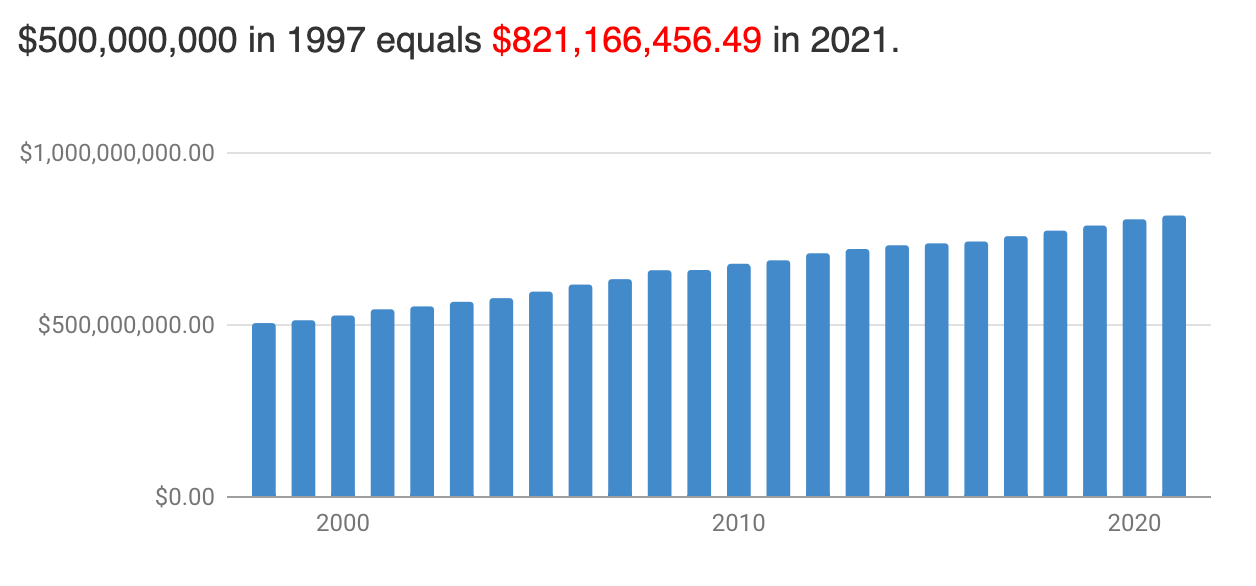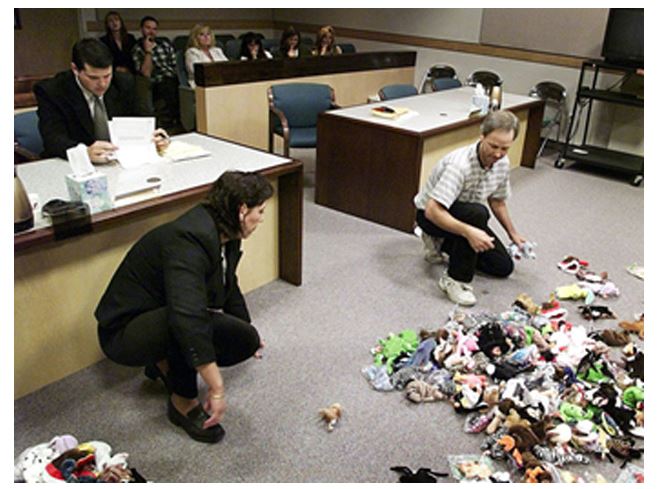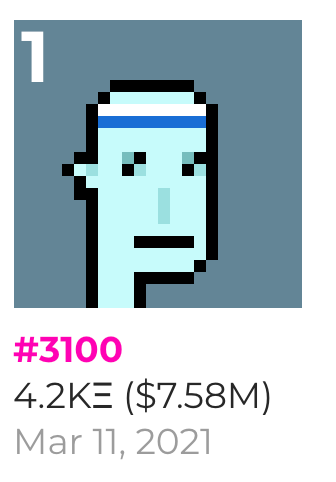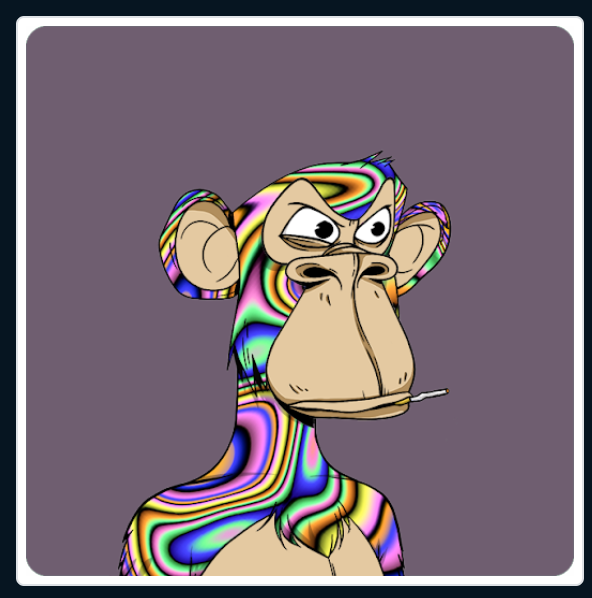Look, I'm not an expert in NFTs. Nor do I know much about Beanie Babies. But I know just about enough about each to know that there are lots of similarities.
And thus I declare; NFTs are the Beanie Babies of the 2020s.
They don't need to be, but they are.
While we're setting the stage for this post, I'm going to assume you know what NFTs and blockchains are. Most people who come across my blog are more technically savvy than me anyway. But if you'd like a primer about what NFTs are, I googled it for you.
Everyone is going on about the potential of web3, and how it is going to be, like, The Future. And for most of those everyones, web3 basically just means NFT collectables.
Briefly, NFT collectables are unique pieces of content with ownership verified via a blockchain.
OK, so "everyone" in this case is mostly people below the age of 39. And granted, since they would inevitably be the same ones contributing to what would be The Future, it might be a self-fulfilling prophecy.
But I do think it's a concept worth exploring, because I, too, fall into that category. I absolutely see the potential for blockchain-verified ownership. But I'm also kinda dismayed by all that's happening. Because currently, I just see all that potential being swept aside and manifesting as digital Beanie Babies for rich people.
Incidentally, the same demographic who are freaking out about NFT lion-punk-apes would probably not remember what Beanie Babies were about, so we'll start off with some story-time.
Beanie Babies
Beanie Babies, my dear reader, were a bunch of collectable toys in the 90s that had a large chunk of society lose their collective minds there for a bit. They were considered one of the first "internet" collectables. Web1 NFTs, if you will.
These were limp, synthetic plush toys filled with too little plastic "beans" and ascribed tremendous value by lost souls on the internet. They were toys that sold for a couple of dollars, but which magically became "valuable collectables" and then resold for thousands of dollars in the secondary market. Yes, Thousands.
The basic drivers of the Beanie Baby craze were the following factors;
- Novelty - Constantly churning designs
- Scarcity - Limited production runs per design
- Hype - Marketing driven by the newly founded World Wide Web
- Distribution - eBay sales and deals with toy stores and McDonalds.
People went batshit for these things. They would scour the internet to try and guess which Beanies would be discontinued when, and which ones would likely shoot up in value a little bit later. Demand for these "collectables" sky-rocketed because, well, demand sky-rocketed.
In 1997 eBay alone handled $500m worth of trades in secondary Beanie sales. Let me inflation adjust it for you. At the time of writing, that comes too $821,166,456.49.

Other factors also added to the mystique and allure - some of these toys were connected to current events, like the Princess Di Beanie, and collectors started creating their own catalogs to drive awareness.
The sports world started dipping their toes in the craze as well. 20 of the 30 major baseball leagues made deals with Ty, the manufacturer to brand their own Beanies.
Revenue going to Ty alone was estimated to be $1.4B by the end of 1998 - this is EXCLUDING the secondary market sales.
People were so desperate to buy these things because they could potentially be worth a lot of money. And they could be worth a lot of money because people knew that others were desperate to get them... because they could be worth a lot of money.
These toys were seen as an investment, dear reader. Because, you know, they were scarce and in-demand. This was a serious enough business to even be part of divorce proceedings.

And why not? Why wouldn't cheap-to-make, stuffed toys continue to be valued into the thousands of dollars for the indefinite future? Hype springs eternal, does it not?
Well, maybe not. By 2004 the Beanie craze had all but collapsed. Popular culture had moved on and society in general realised that maybe this was all just silliness. Stuffed animal toys were not really worth thousands of dollars just because they were scarce and came in limited designs.
You young guns out there might think this all mighty silly. The absolute frenzy that these stuffed toys created decades ago surely doesn't in any way relate to the frenzy we're seeing with animal jpegs, right?
NFT Collectable
Ok, I said I won't do this but let's get a basic idea of what a NFT collectable is.
An NFT is a unit of data stored in a digital ledger(a blockchain). This data can be linked with anything really - images, video, audio, a saxophone. Whatever. But basically, when people buy NFTs, they buy certificates of ownership securely stored on a blockchain. Once created, it can't be fucked with.(That's an alternative word for the "F" in NFT I want to popularise)
NFTs are bought with cryptocurrency, which enables the blockchain to record the transaction as per the digital contract, non-fungibly.
So, OK - just to be clear - when someone brags about buying that monkey-lion image on Twitter, what they actually bought was a blockchain verify-able certificate of ownership, not the actual image that you are looking at. Does that make sense?
As in, I can still just download their NFT-linked picture and set it as my Twitter profile too(for now). No boots would come kick down my door. Only internet people will think ill of me.
With that mediocre explanation out of the way, let's now look at some of the popular NFTs doing the rounds. Let's consider CryptoPunks and Bored Ape Yacht Club.
CryptoPunks
CryptoPunks were a series of 10,000 computer generated images of "punks" slapped on Ethereum in 2017. They were the OG of NFT droppers.
Initially created as an art project, they were released for free, and within a day or so, all 10K of them were slurped up. Understandable - they were free, but within that same period something weird happened. A secondary market appeared, where people started trading them for ETH. And by the Saturday after release, one Punk traded for 10ETH($3,500 at that time). Bonkers. But so is traditional luxury art in general, isn't it?
They now go for even more insane amounts of money. For example, recently, punk #3100 went for $7.58m. That is a wee bit more expensive than the most expensive Beanie ever was.

Bored Apes
The creators of Bored Ape Yacht Club had a look at what CryptoPunks did, scratched their chins a bit, and then got swiftly to work.
They also created 10,000 uniquely generated images, in this case, Apes. Like the Punks these Apes also all face to the right, with the aim of encouraging the holders to use them as profile pics(a nice little viral trick, isn't it?).
But unlike the Punks, an Ape's starting price was 0.08ETH. About 30 Apes were kept off-market initially, so a total of 797ETH went to the makers on release. Or around $2M in total. Nice!
Did the price affect people getting them? Not at all. All available Apes got grabbed within a day.

But another important innovation they pioneered was to tie ownership of an Ape to being part of an exclusive community - the Bored Ape Yacht Club. But of course, you don't need a yacht, just an Ape.
Anyway, this community aspect got folks excited. Community members could now draw on a shared HTML canvas called THE BATHROOM. There are also other Discor..., BAYC channels where community members could discuss, I dunno, Ape things.
BUT! This community aspect has other benefits - new releases of related NFTs and thus continued sales to the creators. The creators continually stay involved and come up with some creative add-ons, like Mutant Apes, which keeps the wave peak moving and brings in even larger sums of money as time goes by.
NFT project Bored Ape Yacht Club raised $96 million in a public sale of 10,000 Mutant Apes in a single hour on Saturday night, and airdropped a further 10,000 vials of mutant serum that let existing holders of the Ethereum-based NFT mint new apes for free.
Try explaining that to your grandma.
Additionally, the holders of Apes also hold creative and usage rights for said Ape. Like crypto copyright. Not sure if these rights would be upheld by a court of law, but really, it doesn't matter. The community is very happy.
Aside from the crazy valuations, I actually do think this is quite a fun and quirky project.
How Beanies and NFTs are similar
Now, let's get to the meat of the comparison.
If you scratch the surface a bit and look at the sales drivers, Beanies and NFTs start looking similar. The basic drivers behind the explosion in popularity for NFTs;
- Novelty - Constantly churning designs
- Scarcity - Limited production of units
- Hype - Marketing driven by social media, Discord & the media
- Accessible distribution - OpenSea, Sorare & Rarible
There's also the shared communities of collectors who trade, catalog and hype them up.
And then, most importantly, these are all objectively useless and worthless in the real world. OK, if I'm honest that's not 100% true - at least a child can cuddle a Beanie. But, normal people will think this all insanity and stupidity. The valuations are thus purely social.
How Beanies and NFTs differ
With Beanies, supply was controlled by the manufacturer, Ty, who could pull the levers to control scarcity. With NFTs, there are a multitude of players dropping product all the time. And for this reason, I also suspect that the NFT fad might come in waves and last longer than the Beanie one did, purely just because of the scale of the movement.
Beanies were also more in the domain of the middle class, while NFT markets seems to be the playground of the super rich.
And finally, Beanies were actual real, physical products. NFT collectables are basically db entries linking a wallet address to a media file. If you owned a Beanie, you held it in your own sweaty, grubby paws. You could directly control it. You could put it in a safe-box or under your bed.
If you own an NFT(to proudly signal your wealth and exclusive community membership), I could still download it, draw rude pictures all over it, and share it with the wider internet.
And that's the part where this NFT hype goes completely la-la-land for me. The valuations for what these things go for do not compute. There are millions of them. And more generated each day. Sure, they are "unique", but so are foam bubbles. Or earthworms. Ok, sure, they are non-fungible, but so what?
And think about it; novel, physical objects should then be even more rare and therefor arguably more scarce than any NFT. It's harder to copy, harder to trade, and harder to find, and you control the actual "instance" of it physically.

NFT's, well, anyone can just use your ApeLion and set it as their Twitter profile. Most people won't know or care to verify. The police won't go and tell them off. Only the "community" would care.
Incidentally, I bet that the same value/hype dynamics would be possible even if ownership was verified on a traditional database operated by OpenSea or whatever, ie the web3 component might not really have to even come in to play here. It's not really about the tech - it's all about hype and status signalling.
Does scarce automatically equal valuable?
I don't think so. In fact, I'm wondering if the real value of NFTs could not lie in the fact that you can just indefinitely generate a new ones and treat them as disposable, yet immutable. There are some interesting use-cases there.
I don't think the NFT craze has anything to do with real value, or scarcity, for that matter. No, it comes down to three things;
- rich people flexing
- internet celebs shilling
- Regular people trying to make a quick buck 'trading'
And honestly, this makes me sad. Especially the middle one.
A few people I follow on Twitter, that I respected as awesome indie-makers or product maestros, recently started shilling NFTs almost exclusively. There's no more real-world wisdom from them, just "buy these pictures I'm dropping, LULz!11!" tweets.
And they're making bank, don't get me wrong. But it all feels so empty. Surely this is not The Future.
Web3 is not just cartoon images
At least, it shouldn't be. There is enormous potential in blockchain-based applications.
And don't get me wrong, for artists to be able to make money directly from supporters is really awesome! The Punks and Lions things were actually interesting.
Other cool things could be done with other forms of art, like music and film. God know's musicians need to be saved from the soul crushing streaming industry.
But we should not get stuck there. And we definitely shouldn't turn it into a digital tulip mania.
The club thins BAYC have going is almost there in real-world application and will eventually get there too, I bet. For instance, if it could be tied to having access to real-world applications - like a timeshare yacht that only Ape holders can board - that would be really cool!
Or perhaps NFTs could be tied to fractional share ownership. Time-restricted access to hotel rooms. Or car rentals, or ride-sharing. Season tickets! Warranty programs, degree or course certifications, content licensing, digital signatures... the possibilities are really endless.
And some people are, in fact, doing some rather cool stuff with web3, like the folks at DESO. Decentralised social media? Hell, yeah! That's something interesting and useful sounding! They also pioneered the idea of creator coins - to free creators from centralised platforms like Patreon.
I don't know, I just feel that all this creative frenzy going into web3 should be tied to benefiting the real-world again.
But perhaps I'm just old and out of touch.
Thanks for reading.
If you have any comments or suggestions, follow and contact me on Twitter @RikNieu. If you want to read more of my rants, sign up below and I'll mail you when I post new stuff. 👇
